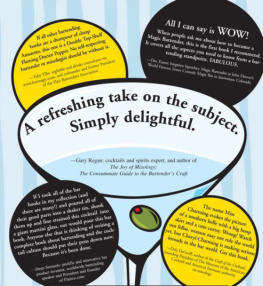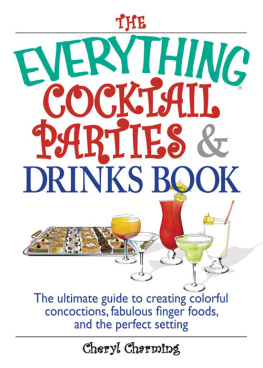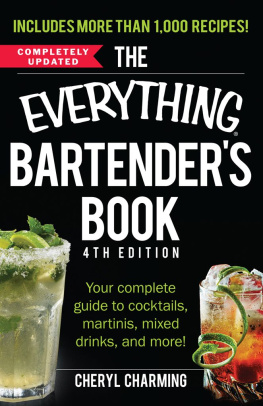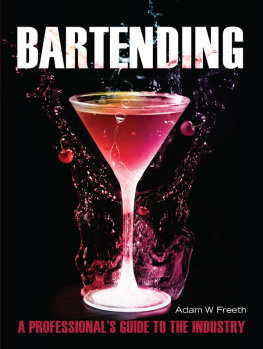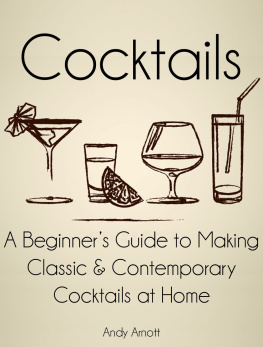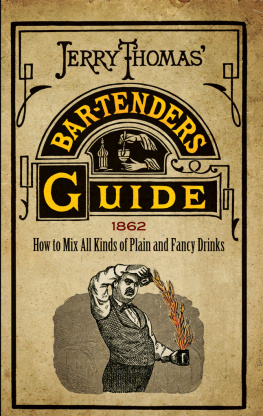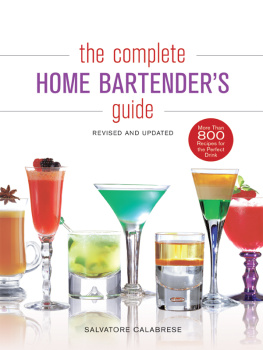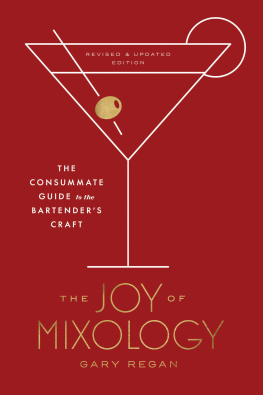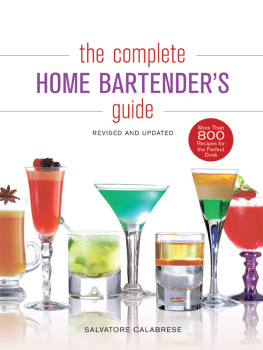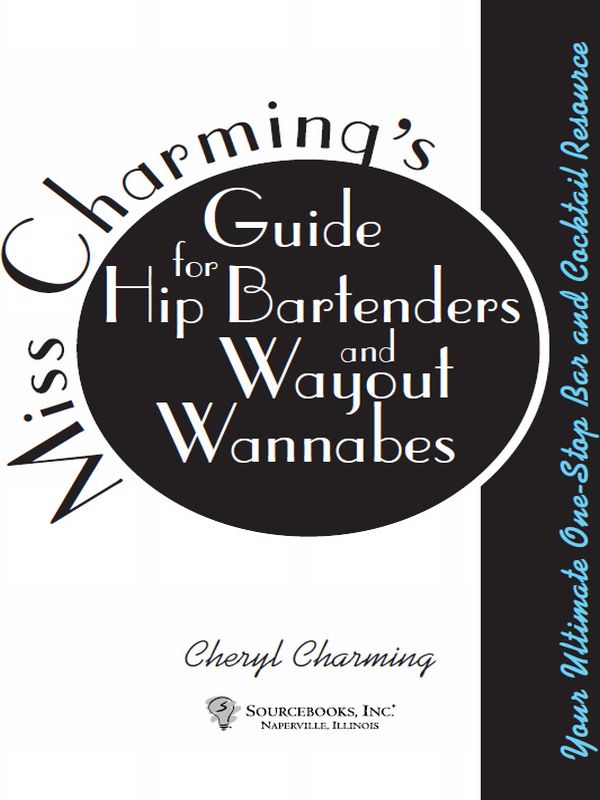
Copyright 2007 by Cheryl Charming
Cover and internal design 2007 by Sourcebooks, Inc.
Internal illustrations Cheryl Charming
Sourcebooks and the colophon are registered trademarks of Sourcebooks, Inc.
All rights reserved. No part of this book may be reproduced in any form or by any electronic or mechanical means including information storage and retrieval systemsexcept in the case of brief quotations embodied in critical articles or reviewswithout permission in writing from its publisher, Sourcebooks, Inc.
All brand names and product names used in this book are trademarks, registered trademarks, or trade names of their respective holders. Sourcebooks, Inc., is not associated with any product or vendor in this book.
Published by Sourcebooks, Inc.
P.O. Box 4410, Naperville, Illinois 60567-4410
(630) 961-3900
Fax: (630) 961-2168
www.sourcebooks.com
Library of Congress Cataloging-in-Publication Data
Charming, Cheryl.
Miss Charmings guide for hip bartenders and wayout wannabes : your ultimate one-stop bar and cocktail resource / Cheryl Charming.
p. cm.
Includes index.
ISBN-13: 978-1-4022-0804-1
ISBN-10: 1-4022-0804-9
1. Bartending. 2. Cocktails. I. Title. II. Title: Guide for hip bartenders and wayout wannabes.
TX951.C474 2006
641.874dc22
2006024101
Printed and bound in the United States of America
CH 10 9 8 7 6 5 4 3 2 1
This book is dedicated to every style of bartender and wannabe bartender on earth.
Acknowledgements
First and foremost Id like to raise a glass and toast my agent, June Clark. She never gave up in finding a publisher for this book, and I appreciate her efforts more than she knows.
Next, a Champagne pyramid of toasts to Sourcebooks, Inc., for having the guts to publish a book that is, quite frankly, the first of its kind. Youve helped the F&B industry in more ways than youll ever know. Special individual toasts go out to editor, Bethany Brown; project editor, Erin Nevius; publicist, Tony Viardo; copy editor, Rachel Jay; and awesome book designer, Dawn Pope. Cheers to all of you!
A special top-shelf toast goes to all of my cocktail culture friends and acquaintances that have supported and believed in me for many years. You know who you are. An ultra-premium straight up cheers to you!
And of course, a loving toast to my family and friends, who always wonder when Im going to get a real job, but support and love me anyway.
Introduction
Once upon a time in a land far, far away, while taking a shortcut through the meadow, a raven-haired girl accidentally dropped a bunch of ripe grapes and a carving knife into a patch of wild mushrooms. The yeast from the mushrooms began to ferment the sweetness of the grapes with much help from the yellow ball of fire in the sky. The next day the girl retraced her steps to locate her lost carving knife and, once found, realized she dropped her grapes as well. She decided to rest for a spell, partake of some grapes, and watch white puffs dance in the sky. She felt warm and loved. Later, the clan medicine woman noticed a change in the girls manner and sought answers. The secret of alcohol is born, then used in ceremonies, celebrations, worship, and medicine for many years to come. All live happily ever after.
Of course no one knows when, how, or who first discovered alcohol, but scientists and archeologists tell us that it dates back to 7000 B.C. And of course, if youre a believer of the Lost Continent then it goes back even further.
What we do know is that humans are social beings and social gathering structures have been part of daily life for a long time. The Greeks had symposiums for the intellectual upper class; frescos show men reclining being served food and wine, while playing games as flute girls and various entertaining acts roamed the room. The Romans were less formal due to so much traveling and actually preferred setting up portable tavernae (taverns). Soon permanent tavernae were built on all roads that Roman troops traveled. All roads lead to Rome! Barmaids served soldiers wine, food, music and danced, and if so desired, then led them to rooms with harlots. Roman troops also carried grapevines with them on every journey to make wine on the road. England began creating their own taverns, and since grapes didnt grow well in their area, they made ale. Soon taverns were found in every town with women given the responsibility of making the beer and wine because it was considered an extension of bread making. Even then, women were the servers at the banquet of life.
Taverns, inns, and public drinking houses (pubs), alehouses, and taprooms pretty much stayed the same from the 1000s to the 1700s. All had fireplaces for warmth, lanterns for light, furniture for sitting, and lots of drink while discussing current events, complaining about the weather, telling stories, and making wagers.
Its mind boggling to think about the many hats a tavern keeper and his ale-wife had to wear. They had to own land in which to grow carbs to make beer, wine, mead, and cider, as well as food for guests. This meant they owned farm animals and tended a garden. They had to provide rooms to house people and stables with hay and water for horses. And they also had to be literate enough to keep books and bills and collect payments due as well as manage the hired help. To multitask, a kitchen dog was placed in a wheel called a turnspit dog, and the dog would walk inside the wheel turning the meat as it roasted over the fire. Tavern floors were often made of sand, and it was common to have a portcullis grate around the bar area. For wagering, there was the tavern puzzle jug, which was a drinking jug with several holes with only one working hole to drink from. So the tavern keeper was the barkeeper as well as many other keepers. Maybe thats where the term, Hes a Keeper comes from?
We know what taverns, pubs, and drinking houses looked like in the 1600s because Dutch artist Jan Steen painted many daily life scenes on the subject. After viewing his paintings you begin to realize that drinking houses basically had the same things we have today: alcohol, drinking vessels, tables, chairs, music, flirting, fire, food, laughter, games, gambling, and even a tavern keeper flairing a long pour from a wine jug into a Martini shaped glass. However, there were a few differences: lots of children, messes, dogs, cats, chicks, and pigs. On second thought, maybe not.
The 1800s were magical years for barkeeps, barmaids, and bartenders in bars, pubs, taverns, saloons, and inns across America. The times brought on civilized behavior with new technological advances. One could order a Sling, Grog, Flip, Sazerac, Manhattan, Rob Roy, Toddy, Tom Collins, Cobbler, Crusta, Smash, Sour, and more. Popular spirits and mixers were beer, wine, cider, whiskey, apple brandy, applejack, gin, rum, bitters, egg whites, Port, absinthe, amaretto, rye, scotch, Bacardi, mint, vermouth, soda water, brandy, anisette, Sherry, syrups, juices, Southern Comfort (known then as Cuff & Buttons), Jack Daniels, and Coca-Cola. The position of a bartender, even though blue-collar, was seen as aristocracy of the working class. In those days you had to be a bartender apprentice for several years before you could be a bartender. The first known celebrity bartender was Jerry Thomas. Jerry learned the craft in New Haven, Connecticut, then traveled west to San Francisco. He then traveled back east to New York and opened four saloons. The first one can still be seen at Broadway and Ann Street below the Barnums Museum. After that he traveled and worked as a head bartender in St. Louis, San Francisco, Chicago, Charleston, South Carolina, and New Orleans. With a set of solid silver bar tools he set sail for England and France. Thomas published
Next page
